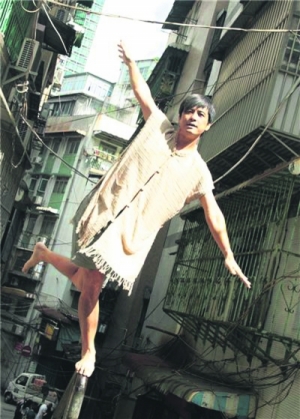 |
2017年12月
In the second-to-last morning of the six-day inaugural “City Contemporary Dance Festival” (CCDF), organized by the 38-year-old City Contemporary Dance Company (CCDC), a major issue was raised at the “ChatBox: Re-Imagine Dance in Asia”, co-organized by the International Association of Theatre Critics (Hong Kong) [IATC-HK].
Having already watched, by that morning, 19 contemporary dance works of various lengths, scales and subject matters by independent choreographers and well-established dance companies from Hong Kong, Japan, Taiwan, Macau and China, a European producer questioned the contemporaneity of East Asian dance and how it differs—or whether it should—from the European counterpart.
An evening before at the main entrance of Kwai Tsing Theatre, a Hong Kong dance teacher asked a question I personally have not heard addressed to me: “Is this your first time to Hong Kong?” My answer—the fact that I visit Hong Kong at least twice a year for the past 10 years—surprised her. Once inside the proscenium theatre before the start of NINA—materialize sacrifice by Japan’s Noism1, another European producer seated one row behind me was heard complaining to her compatriot, “Why don't we get to watch TAO Dance Theatre?” To that my answer was a silent whisper to myself and thus would not have surprised her, “Because they're busy touring Europe, perhaps.”
It is evident here that many dance festivals in Europe have been performing the role of gatekeepers—rather than gateways—in such a way that when it comes to contemporary Asian dance, many European audiences are expecting certain amount of interaction between modernity and tradition. And without the latter they may deem the work insignificant or old-fashioned. This is despite the fact that most contemporary Asian choreographers, given their training background, are neither trained nor interested in traditional arts—and most contemporary dance works that Asian audiences are watching have little, or nothing, to do with tradition as well. But the bottom line is: We cannot simply assume that all Asian choreographers think and work like Lin Hwai-min, Pichet Klunchun and Eko Supriyanto, can’t we?
It is widely known, and generally agreed, that, as the amount of artistic possibility rises, the scope of contemporary dance, like that of contemporary arts in general, is ever expanding. With this in mind, one has to wonder whether the aforementioned point of view towards contemporary Asian dance, in this day and age when many Asian countries’ technological advance far exceeds that of European counterparts, can be regarded as a kind of neo-colonialism. And so let our debate continue.
Every performing arts festival has a curatorial scheme, and so did CCDF. A month has already passed and yet the image of the opening scene of NINA—materialize sacrifice is still fresh in my mind. The discipline instilled in Noism1’s female dancers’ bodies was so high that it took me many seconds before I realized that they were humans, not mannequins, and I do not need to see my optometrist anytime soon. As obvious as it might sound—and of course contemporary dance does not need to be abstract—the contrast between the manipulating male dancers’ movements and the manipulated female counterparts’ throughout this full-length work was proof of strong dramaturgy which also reflected the technologically advanced and highly patriarchal society.
Works that premiered more than a decade ago like Cold Arrow—Game of Go (Weiqi) by China’s BeijingDance/LDTX’s and Moon-Looking Dog by Korea’s Daegu Contemporary Dance Company did not look dated either. With their firm places in the history of contemporary dance in both countries, if not East Asia in general, the two works, respectively by choreographers Li Han-zhong and Ma Bo, and Hong Seung-yup, serve as links, or references, to what and how the younger generations of artists are working today. As the former was presented at the multi-purpose auditorium of Yuen Long Theatre where the audience in the stalls could not see the stage floor though, most of us could not see the squares of the game board and missed some important Chinese images and how they were connected to the dancers’ movement.
Apart from the dancers’ technical prowess and the choreographers’ insight, music and production design play important roles in contemporary dance. Some choreographers take as their inspiration existing music scores, either famous or lesser-known ones, and, accompanied by one complete number after another, their works may sound and look familiar for some audiences, especially those with European gaze. Meanwhile, others, with more resources, have composers or sound designers create the soundscapes that are more specific to their works—and three noteworthy examples are France-born Vietnamese composer An Tôn Thât’s for NINA, his Korean counterpart Kim Te-kn’s for Moon-Looking Dog and Japanese colleague Chikako Ezawa’s for Co. Un Yamada’s one◆piece.
At our ChatBox, my IATC Swedish colleague Cecilia Djurberg made another poignant note on the lack of conceptual dance works in this festival. This also reflects the current situation in East and Southeast Asia in general. In these regions, the number of dance students far exceeds that of professional dancers and that of dance schools and studios and that of dance companies. Besides in many dance curriculums, like their counterparts in other performing arts genres, the focus is on the perfection of the movement skills, and rarely on choreography. There is also little to no connection to other performing arts genres even though they are in the same institution. This is clearly the opposite to the situation in Europe where many choreography programs put forth the interdisciplinary nature of contemporary arts and are now even admitting students without dance background.
It should also be noted that CCDF’s evening programs, with large-scale works by renowned companies and post-show discussions, attracted a considerable number of local audiences. However, the early-to-mid-afternoon counterparts, with Hotpot and Hong Kong Focus programs, featuring shorter and smaller-scaled works by smaller companies and independent artists, were attended mostly by the festival’s international guest artists, presenters, producers and programmers. Venue location and weekday schedule might be reasons but many local audiences missed this rare opportunity to expand their view on contemporary dance having missed these works.
Another area CCDF, and other performing arts festivals in East and Southeast Asia, should consider paying more attention to is the audience development. Contemporary dance deals with a vast range of subject matters and as a result should relate to a much wider group than the typical dance audience, which in these regions comprises a number of former and current dance students. Hence, it should never be discussed as an art form, but also, in accordance with each audience’s interest, socially, culturally and politically as well. This can begin simply by providing more information on each work and related artists—such as excerpts from their interviews and previous works—in the festival’s program book and website. List of, or links to, related materials and pre- or post-show discussions with scholars in other fields can also be added to make sure that the impact of each contemporary dance work last longer in the audience’s everyday life, as it should be.
In the end, my experience of CCDF is similar to that of Suzanne Dellal Center for Dance and Theater’s annual “International Exposure”, plus the bus rides when I had time to discuss with international colleagues and make more professional connection. It also makes me look back at myself having attended Hong Kong Arts Festival on an annual basis since 2008 and yet scarcely watched contemporary dance and theatre works from Hong Kong and East Asia here. I can also think back to when I visited Hong Kong for the first time—also the first time I was in a foreign country—in the late 1970s when my enthusiasm was in Japanese toys and McDonald’s Fillet-o-Fish, which was not yet available in my home country. Recently, that has changed to made-in-Hong Kong clothes and some new dim sum creations which are not available elsewhere. That is to say: The Asia’s World City still has plenty more of the local contemporaneity for me, and any foreign visitor, to discover.
That said, CCDF, for its first edition, is already highly commendable for presenting exclusively contemporary dance works from East Asia, and nowhere else—notwithstanding our different notions on what contemporary dance is, and can be.
Postscript
These next two paragraphs were added after my EVA Air flight, from Taipei to Paris a month after CCDF, the new safety demonstration video of which is a dance film, a collaboration between Golden Horse-winning film director Robin Lee and indigenous Paiwan choreographer Bulareyaung Pagarlava. Owing in part to the subject matter which needs to be understood by international audiences, or passengers, and the accompaniment of 3D projection onto the studio set, the work does not contain any folkloric quality. In the immigration queue at Charles de Gaulle airport, I had a discussion with a fellow passenger, a Taipei-based French businessman, who did not enjoy the video as much as I did. We both agreed though that unlike the safety video by another Asian airline which puts in elements of traditional culture here and there in an attempt to attract the audiences to stop over, instead of transiting, this exemplary work projects the image of contemporary Taiwan as it is, without yelling “Welcome to Taiwan!” And more importantly, it had the full attention of us, frequent travelers, who know the content of this video by heart.
That is also to say: the artistic freedom in contemporary dance has also blurred the line among national identities and asked the audience to shift their attention to the individual artist’s unique style and dramaturgy. And if we have an agreement on this, then it is about time we stop the debate on whether or not Tsai Ming-liang’s, Wong Kar-wai’s, Apichatpong Weerasethakul’s works are more like European arthouse than Asian films.
本網站內一切內容之版權均屬國際演藝評論家協會(香港分會)及原作者所有,未經本會及/或原作者書面同意,不得轉載。










